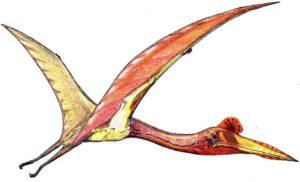Pterosaur, Quetzalcoatlus, Sky Sovereign of the Ancient Winds
You won’t believe the sky-shattering wingspan of Quetzalcoatlus, the giant pterosaur that ruled the prehistoric skies!
Quetzalcoatlus is a titanic flying reptile boasting an awe-inspiring wingspan stretching over 30 feet. Its slender, elongated neck supports a toothless, spear-like beak, perfect for snatching prey or scavenging carrion. Its massive, membranous wings are supported by a single, extraordinarily long finger, giving it a graceful yet imposing silhouette against the sky. Its body is covered in a fine, downy fuzz, aiding in thermoregulation.
Behaviour
Primarily a soaring predator and scavenger, Quetzalcoatlus spends hours gliding on thermal air currents, conserving energy as it surveys vast stretches of land. It is mostly solitary, descending only to snatch small vertebrates or carrion from the ground. While it can launch into flight from flat ground, it prefers elevated takeoff points. Despite its size, it is surprisingly agile in the air.
Habitat
Quetzalcoatlus inhabits coastal plains, river deltas, and open inland environments where updrafts are plentiful. It favors areas rich in carrion or small, slow-moving prey such as hatchling dinosaurs and reptiles.
Modus Operandi
Quetzalcoatlus uses its keen eyesight to locate food from high above, silently gliding close before striking with its sharp beak. It prefers to avoid confrontation, relying on its size and flight to evade larger predators. When threatened, it uses powerful wing beats to create gusts and intimidate foes.
Motivation
Survival and sustenance drive Quetzalcoatlus. Its immense size demands abundant food, motivating it to roam widely. It balances efficiency with stealth, ensuring it remains a dominant yet elusive giant of the prehistoric skies.
Quetzalcoatlus 5e
Quetzalcoatlus, Pathfinder
Quetzalcoatlus
Gargantuan Beast, Unaligned
Challenge: 9 (5,000 XP)
Proficiency Bonus: +4
Armor Class 15 (natural armor)
Hit Points 150 (12d20 + 48)
Speed 30 ft., fly 80 ft.
| STR | DEX | CON | INT | WIS | CHA |
|---|---|---|---|---|---|
| 22 (+6) | 16 (+3) | 18 (+4) | 6 (–2) | 14 (+2) | 9 (–1) |
Saving Throws: Dex +7, Wis +6
Skills: Perception +6 (keen sight)
Senses: Passive Perception 16
Languages: —
Traits
- Flyby. The Quetzalcoatlus doesn’t provoke opportunity attacks when it flies out of an enemy’s reach.
- Keen Sight. The Quetzalcoatlus has advantage on Wisdom (Perception) checks that rely on sight.
- Thermal Glider. When flying at least 30 feet above the ground, the Quetzalcoatlus can take the Dash action as a bonus action.
Actions
Multiattack.
The Quetzalcoatlus makes two attacks: one with its Beak and one with its Claw.
Beak.
Melee Weapon Attack: +10 to hit, reach 10 ft., one target.
Hit: 26 (4d8 + 6) piercing damage.
Claw.
Melee Weapon Attack: +10 to hit, reach 5 ft., one target.
Hit: 18 (3d6 + 6) slashing damage.
Dive Strike (Recharge 5–6).
The Quetzalcoatlus dives at high speed to strike a creature within 60 feet. The target must succeed on a DC 17 Dexterity saving throw or take 36 (8d8) piercing damage and be knocked prone. On a successful save, the target takes half damage and isn’t knocked prone.
Tactics
- Uses Flyby to strike quickly, attacking and then flying out of melee reach.
- Employs Dive Strike to initiate combat, targeting vulnerable or isolated foes.
- Leverages its superior flight speed and the Thermal Glider trait to reposition rapidly and avoid counterattacks.
- Prefers to attack from above, using high ground and surprise to overwhelm prey or enemies.
Environment
Coastal plains, river deltas, open forests, and cliffs where thermals allow effortless soaring.
Treasure
Wing membranes and bone fragments are rare and valued by collectors and shamans alike for their mystical significance.
Quetzalcoatlus

Quetzalcoatlus – A brightly colored creature swoops down to land on the branch above. Its head is overly large, with a mouth full of sharp teeth and bright, shiny eyes. The thing chirps, lashes its long thin tail, and then with a flap of leathery wings is in the air once again.
Pterosaurs are often found in regions where dinosaurs and other prehistoric creatures are commonly encountered, yet they are not dinosaurs themselves. The pteranodon is the most well known and widespread of these flying reptiles, but numerous other species exist, such as the relatively small rhamphorhynchus, the venomous dimorphodon, and the lumbering, giraffe-sized quetzalcoatlus. While the larger pterosaurs are awkward f liers, the smaller ones can be quite agile and quick. Pterosaurs generally dwell on coastlines, along rivers, or near swamps or lakes, for the majority of their diet consists of fish snatched from the water in daring dives. Pterosaurs are quite territorial, though, and most won’t hesitate to swoop down and hiss, shriek, and attack things their size or larger.
| Pterosaur, Quetzalcoatlus CR 7 |
| XP 3,200 N Huge animalInit +7; Senses Low-Light Vision, Scent; Perception +13 |
| DEFENSE |
| AC 19, touch 12, flat-footed 15 (+3 Dexterity, +1 Dodge, +7 natural, -2 size) hp 82 (11d8+33) Fort +10, Ref +12, Will +5 |
| OFFENSE |
| Speed 30 ft., Fly 50 ft. (clumsy) Melee bite +13 (2d8+7/x3), 2 wings +8 (1d6+3) Space 15 ft., Reach 15 ft. |
| STATISTICS |
| Strength 25, Dexterity 17, Constitution 17, Intelligence 2, Wisdom 14, Charisma 12 Base Atk +8; CMB +17; CMD 31 Feats Dodge, Flyby Attack, Improved Initiative, Lightning Reflexes, Lunge, Skill Focus (Perception) Skills Fly -6, Perception +13 SQ razor-sharp beak |
| Ecology |
| Environment warm coastline, swamps, or plains Organization solitary, pair, or flock (3-6)Treasure none |
| SPECIAL ABILITIES |
| Razor-Sharp Beak (Ex) A quetzalcoatlus’s razor-sharp beak has a critical modifier of x3. |

Pterosaurs are often found in regions where dinosaurs and other prehistoric creatures are commonly encountered, yet they are not dinosaurs themselves. The pteranodon is the most well known and widespread of these flying reptiles, but numerous other species exist, such as the relatively small rhamphorhynchus, the venomous dimorphodon, and the lumbering, giraffe-sized quetzalcoatlus. While the larger pterosaurs are awkward f liers, the smaller ones can be quite agile and quick. Pterosaurs generally dwell on coastlines, along rivers, or near swamps or lakes, for the majority of their diet consists of fish snatched from the water in daring dives. Pterosaurs are quite territorial, though, and most won’t hesitate to swoop down and hiss, shriek, and attack things their size or larger.
Perhaps the largest of the pterosaurs, the quetzalcoatlus (known to some as the ‘swamp stalker’ and others by the misnomer of ‘dragonling’) is truly an awe-inspiring sight in the air, with its impressive 40-foot wingspan. On the ground, this creature’s profile bears an uncanny resemblance to that of a giraffe, save for the fact that the folded wings arch up to either side of its lightly feathered body, and its head bears a horrific, razor-sharp beak.
Unlike dimorphodons, quetzalcoatluses are difficult to train. Handle Animal checks made to train one of these looming pterosaurs take a -4 penalty.

 Buy me a coffee
Buy me a coffee